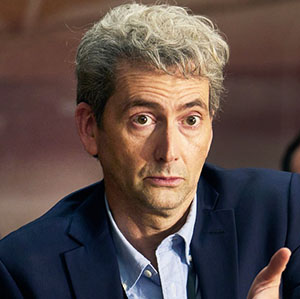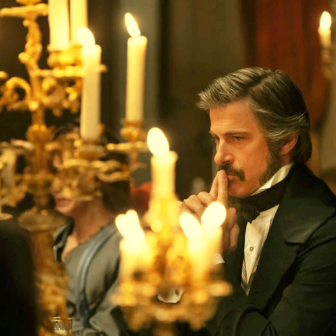Hansom cabs make their way through the fog in London’s Baker Street. Snowflakes swirl around the huddled figures on the pavement, one of whom is hawking copies of Dr Watson’s latest story about the exploits of Sherlock Holmes. Lines from Watson’s narrative are heard in voiceover: “I returned to England with my health irretrievably ruined and my future bleak. Under such circumstances, I naturally gravitated to London, that great cesspool into which all the loungers and idlers of the Empire are irresistibly drained.”
This familiar scene, with its promise of atmospheric horrors, has become a comfort zone of British television entertainment. We know it so well: it’s not just the terrain of Sherlock Holmes, it’s also (with only a little licence in the historical timeline) the world of Jack the Ripper, the Woman in Black, the Woman in White and all the Ghosts of Christmas Past.
Doctor Who’s Tardis might appear anywhere around here, along with a fair selection of the Doctor’s old friends and enemies. After all, it’s where scriptwriter Steven Moffat chose to take him, in his latest reincarnation as Peter Capaldi, in the movie-length special Deep Breath, aired in August 2014. And it looks suspiciously like Matt Smith, Capaldi’s predecessor as the Doctor, has had some of his wardrobe ripped off by Benedict Cumberbatch, the latest Sherlock Holmes, in Sherlock: The Abominable Bride, streaming on Stan. Given that they have the same scriptwriters (Moffat and Mark Gatiss), some identity confusion might be understandable, though this Sherlock Holmes also gets a lot of his lines straight from Conan Doyle.
Cumberbatch, fresh from a recent season in the role of Hamlet at the Barbican theatre in London, seems to be talking to everyone as if they were Rosencrantz or Guildenstern, or both, engaging them in battles of wit that they are bound to lose. Well, that’s postmodernism for you, as some people might say – intertextuality, pastiche, parody and all that. Perhaps it was necessary to take the wonderfully contemporary Sherlock back to the Victorian era to make him truly postmodern. Though postmodernism, so twentieth-century, wouldn’t go down well with the millennials who are Sherlock’s dedicated followers and impersonate him in their thousands at Comic-Con festivals; and the term is redundant, anyway, now that all the things it was striving to identify have become second nature to us.
But one of the problems with the post-postmodern twenty-first-century cultural milieu is that it can’t take anything seriously, and Conan Doyle, at least in the beginning, took Sherlock Holmes and John Watson very seriously indeed. Life and death are always at stake in the Holmes stories, but so are hope and despair, and idleness and heroism, as the old world of the British Empire unmakes itself in the great cesspool of London. Both men are walking the brink, capable at any point of slipping into a permanent state of pathological uselessness. Left to themselves, they might well have been swallowed up in the cesspool, but together they become the dynamic duo.
In every case Holmes trawls into his domain, the psychological tensions are in the red zone. Like their hero, those arch reincarnators Moffat and Gatiss are nothing if not clever, and in many respects they show an acute awareness of what they are dealing with. Their commitment to Conan Doyle’s fictional world is born of enduring and obsessive engagement with the stories on the page. But they also have a commitment to a fan base whose ideas of Victorian England may come almost entirely from last year’s Doctor Who. How can these starkly divergent cultural frames be brought into effective relationship?
During the opening scenes, the milieu of the literary classic is allowed to dominate. Meticulous work on the part of director Douglas Mackinnon (whose credentials as a Victorianist were earned in the series Jekyll), cinematographer Suzie Lavelle, editor Andrew McClelland and production designer Arwel Jones results in a tightly disciplined overture to the story.
Holmes’s consulting rooms at 221B Baker Street are decorated with witty attention to detail: the stag’s head on the wall is equipped with an ear trumpet; the picture of a death’s head is a trompe l’oeil image that becomes, in close-up, the image of a woman at her mirror, her dark head and its reflection forming the eyes of the skull. The characters are deftly reconfigured for the period – and not in especially flattering ways. Watson (Martin Freeman) is upholstered in tweeds and afflicted with a handlebar moustache, Lestrade (Rupert Graves) has sprouted sideburns, and Sherlock has been stripped of his wavy forelock to reveal a starkly accentuated hairline. And, in a touch of rather more anarchic humour, Mark Gatiss as Holmes’s brother Mycroft appears in a gargantuan fatsuit.
Cumberbatch and Freeman meet the challenge of their Victorian personae with relish. The locked-in tensions of Sherlock’s personality take on a physical aspect in a Holmes who moves with stringent formality. His accent has gone up a couple of notches on the social register: the diction is sharper, the vowels more pinched, the pitch of the voice more cutting. Freeman, with the comedian’s timing and eye for body language, draws every nuance out of the dialogue.
As the men have become more stuffy and constrained, the women are given more latitude. Watson’s wife Mary, played with warmth and humorous charm by Amanda Abbington, declares herself a suffragette and spearheads a convoluted subplot through which the patriarchs around her are supposed to learn a thing or two. Una Stubbs as Mrs Hudson complains to Watson that his stories never give her any dialogue. “I’m your landlady,” she snaps, “not a plot device.” Stubbs, always a winning presence on screen, has been short of dialogue her entire career, which is a shame and a sin, since she can nail the punchlines with the best of them.
For the first half hour or so, the script doesn’t miss a beat. The dialogue is fast, full of neat quips and counterquips, the tensions ratcheting up nicely in every scene. I began to feel I was watching a TV masterpiece. But it was a feeling that began to ebb away as the story got going. After a nicely classic scene in a railway carriage, Holmes and Watson arrive at the country mansion where the Abominable Bride, a spectral figure who is a cross between Dickens’s Miss Havisham and the Joker in Batman (Heath Ledger’s version), has begun her reign of terror. All the requisite ingredients for the fin de siècle horror story are assembled, but where is Conan Doyle’s serious commitment to the supernatural? While he never went so far as to impose a magical solution on any of Holmes’s mysteries, the sense of the uncanny in those original stories is powerful enough to lower your blood temperature by several degrees.
Cumberbatch’s Holmes is having none of that. He and Watson keep vigil outside the darkened, mist-bound house while its owner cowers inside, convinced he is about to be dragged to hell by a risen corpse in a wedding dress. “That’s a lot of nonsense, isn’t it?” says Watson. “God yes,” Holmes replies. “Did you bring your revolver?” But what good would that be, Watson protests, against a ghost? “Exactly,” Holmes retorts. “Did you bring it?” As they wait through the small hours, the repartee between the two men goes on and on, as it does in every scene they have together. It’s an endless display of pointscoring, in which the only tone is one of increasing irritation and the only goal is the display of cleverness.
Cleverness is what ruins this bizarre Christmas pudding of a drama. As more and more ingredients are stirred into the plot, we start doing the time warp. Holmes wakes from a deep sleep on a plane that is just landing in London in 2015. Has he dreamed it all? Or perhaps it is the later Sherlock who is a mere hallucination? Back in the world of fogs and hansom cabs, Holmes is discovered lying on the floor under the influence of the seven per cent solution. But he’s soon up and about, off to the Reichenbach Falls to do the death roll with Moriarty all over again.
Apologies if these are plot spoilers, but it’s hard to tell what might ruin the suspense when the plot has been so thoroughly spoiled in the first place. Suspense requires a certain imaginative economy, a concentration of focus in well-defined parameters. Don’t expect any of that. As for other kinds of expectation, all bets are off. By the end, I wouldn’t have been remotely surprised to see the Daleks parading down Baker Street. What a waste of talent and opportunity. I suppose the fans will love it. I kind of hope they do. •




